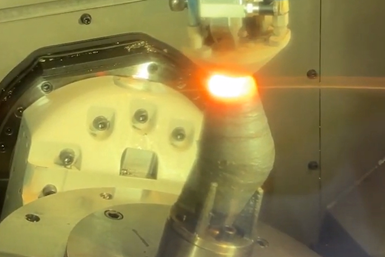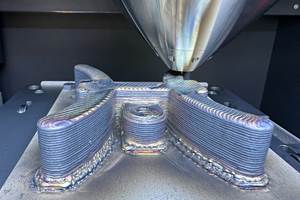Additive/Subtractive Hybrid CNC Machine Tools Continue to Make Gains (Includes Video)
The hybrid machine tool is an idea that continues to advance. Two important developments of recent years expand the possibilities for this platform.
Share






The hybrid CNC machine tool is an idea that continues to advance.
This is worth seeing. The term, “hybrid,” refers to a machine tool that is also something more — usually it connotes combining additive manufacturing (AM) and the machine tool’s normal work of “subtractive” machining within a single machine able to mix both operations in a single cycle. As a working concept, the idea is a decade old. Applications are not so widespread that hybrid machines are found in typical job shops, but applications are numerous enough to offer an expanding market that continues to be served. The hybrid machine tool is, in one sense, a niche technology. In another sense, it is something more, because there is a diversity of niches in which the technology offers promise.

View of a metal 3D printing operation on a hybrid machine tool from Mazak. This shot is a still from the video below on the hypersonic missile nosecone.
At a distance, the hybrid machine tool seems just provocatively useful. The machine offers the chance to begin with an empty work zone, and not only create a part the way a 3D printer can, but also machine it to its required tolerances as part of the same cycle. Considered more closely, the hybrid model poses some challenges. But the matter of when to use a hybrid and what it can do is not at an end. In the last several years, I have seen at least two major developments that seem to me to have opened wider the extent of how useful a hybrid machine can be.
First, the limitations. The hybrid idea inherently means one machine carries the capabilities of two, but puts only one set of capabilities to work in any moment. The potential for process imbalance thus means the machine, while versatile, is not necessarily efficient for a given application. A part made complete using metal 3D printing and machining might require only one-third as much machining time as the 3D printing. This being the case, it is possible that two or three single-purpose AM machines used in tandem with one single-purpose CNC machine tool might provide a faster and cheaper solution if the use is recurring production.
This limitation is why cladding and repair are two applications in which hybrid often is an attractive choice. Cladding does not involve 3D printing a complete form that also needs machining, but instead involves adding a layer of material to a surface ahead of machining. Additive and machining time are balanced enough that one is not kept waiting long within the shared cycle. Something similar is true of using a hybrid machine to repair a valuable tool or part: Restoring the worn or damaged feature calls on both 3D printing and machining, using them both nearly enough in balance and in tandem that the hybrid machine is far more capable and efficient than trying to perform the same repair through multiple separate operations and setups.
Another limitation, or at least a consideration, is this: Hybrid machine tools performing 3D printing generally do so through laser metal deposition, meaning the machine shop adding this type of machine must add laser melting to its mix, likely an unfamiliar capability. Some hybrid machines also employ powder metal as the material stock, which, for the typical shop, is apt to be an unfamiliar material choice with new safety considerations to accommodate. Yet this latter detail points to one of the developments of the past several years that I see bolstering hybrid’s promise. Namely, wire-fed deposition systems arrived as an additional option. The laser is still there as a new system to learn, but spools of wire are a much easier form of metal stock to handle and manage.
Here is the other major development that I see helping hybrid: The COVID pandemic and its effects on logistics and supply turned seemingly all manufacturers’ attention to their supply chains. Steps such as casting or assembly might add considerable lead time, complexity or supplier vulnerability to a given product’s process, and the impact of this is now seen and questioned to a greater extent than it was just a few years ago. A hybrid machine can overcome casting by making the part from scratch; it can overcome assembly by allowing machining to generate precise internal features of a complex form as the part is being built. Where quantities are low enough, the chance to bypass casting or assembly in this way is potentially valuable enough to overlook any cycle time inefficiency in the machine that can deliver this simplified, responsive, on-demand part making.
And this is where we are now. Hybrid is an option for cladding and repair, and we should watch for its application to expand as an option for complete parts as a workaround for steps that might otherwise involve time or complexity. The two major developments I cite are interrelated, since we should not discount the ease and safety of material use as a factor aiding adoption as a supply chain solution. An extreme case: The Navy warship USS Bataan now carries a hybrid machining center with wire feedstock as a method of .
Then there is still more related to brand new markets, and new possibilities. Again, the term “hybrid” refers to a machine tool that is also something more — usually additive manufacturing, but perhaps some other capability. Machine tool builder Mazak, for example, makes hybrid machine tools combining machining with friction stir welding. One promising market is electric vehicles. The battery trays of these vehicles need to be sealed; traditional welding’s heat risks damaging the battery. Mazak executives say various major automakers are therefore evaluating friction stir welding hybrid machines tools as an alternative, not just to reliably and precisely seal the battery compartments in a joining process not using heat, but then also, as an added benefit, to go on to machine those battery compartments to tolerance within the same cycle and setup.
Learn more about friction stir welding in the playlist of related video below.
Related Content
6 Trends in Additive Manufacturing Technology
IMTS 2024 features a larger Additive Manufacturing Pavilion than ever before, with veteran suppliers alongside startups and newcomers at the front of the West Building. As you browse these exhibitors, as well as booths found elsewhere at the show, keep an eye out for these trends in AM.
Read MoreDigitalization and Done-In-One Reign Supreme at BIEMH 2024
European manufacturers may have a different balance of markets than their U.S. counterparts, but the practical challenges they must overcome are often similar — as are the solutions.
Read MorePush-Button DED System Aims for Machine Shop Workflow in Metal Additive Manufacturing
Meltio M600 metal 3D printer employs probing, quick-change workholding and wire material stock to permit production in coordination with CNC machines.
Read MoreHow to Meet Aerospace’s Material Challenges and More at IMTS
Succeeding in aerospace manufacturing requires high-performing processes paired with high-performance machine tools. IMTS can help you find both.
Read MoreRead Next
Last Chance! 2025 Top Shops Benchmarking Survey Still Open Through April 30
Don’t miss out! 91ÊÓƵÍøÕ¾ÎÛ's Top Shops Benchmarking Survey is still open — but not for long. This is your last chance to a receive free, customized benchmarking report that includes actionable feedback across several shopfloor and business metrics.
Read MoreMachine Shop MBA
Making Chips and 91ÊÓƵÍøÕ¾ÎÛ are teaming up for a new podcast series called Machine Shop MBA—designed to help manufacturers measure their success against the industry’s best. Through the lens of the Top Shops benchmarking program, the series explores the KPIs that set high-performing shops apart, from machine utilization and first-pass yield to employee engagement and revenue per employee.
Read MoreAMRs Are Moving Into Manufacturing: 4 Considerations for Implementation
AMRs can provide a flexible, easy-to-use automation platform so long as manufacturers choose a suitable task and prepare their facilities.
Read More






















